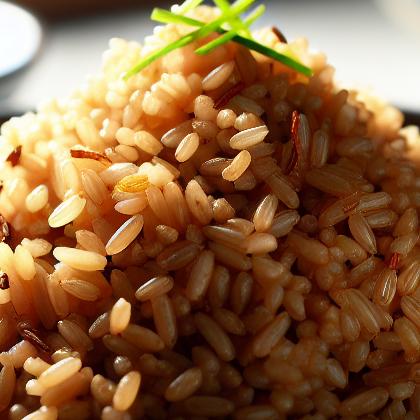Showing results for 'Brown rice'
close
Brown Rice

Brown rice (or "hulled" or "unmilled" rice) is whole grain rice. It has a mild, nutty flavor, and is chewier and more nutritious than white rice, but goes rancid more quickly because the bran and germ—which are removed to make white rice—contain fats that can spoil. Any rice, including long-grain, short-grain, or sticky rice, may be eaten as brown rice.
Brown rice Pairs With:
Food Item
Flavor Affinity Level

Did you know there are 128 food flavor pairings in my database for Brown Rice available. What you are seeing above is a random list of 30 items which pair with Brown Rice.
For the entire list, beautifully formatted, enter your email address and click the download button below, then I'll email it to you as a PDF.
Brown rice Properties:
| Food Property | Type | Description |
|---|---|---|
| Texture | Firmness | Brown rice has a firm texture, with each grain retaining its shape and structure when cooked properly. |
| Nutritional Value | Macronutrients | Brown rice is rich in carbohydrates, providing a good source of energy. It also contains some protein and minimal fat. |
| Micronutrients | Brown rice is a good source of essential minerals such as magnesium, phosphorus, and manganese. | |
| Fiber | Brown rice is high in fiber, specifically insoluble fiber, which aids in digestion and promotes bowel regularity. | |
| Phytochemicals | Brown rice contains phytochemicals such as phenolic compounds and flavonoids, which have antioxidant properties. | |
| Color | Natural Pigments | Brown rice gets its color from the outer bran layer, which is rich in natural pigments such as anthocyanins and carotenoids. |
| Aroma | Volatile Compounds | Brown rice has a subtle, nutty aroma due to the presence of volatile compounds released during cooking. |
| Chemical Composition | Acidity/Alkalinity (pH) | Brown rice is slightly acidic in nature, with a pH range of 6.0-6.5. |
| Cooking Behavior | Water Retention | Brown rice has a tendency to absorb water while cooking, requiring a specific water-to-rice ratio for optimal results. |
Food Pairing App - Version 1.2.0
